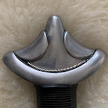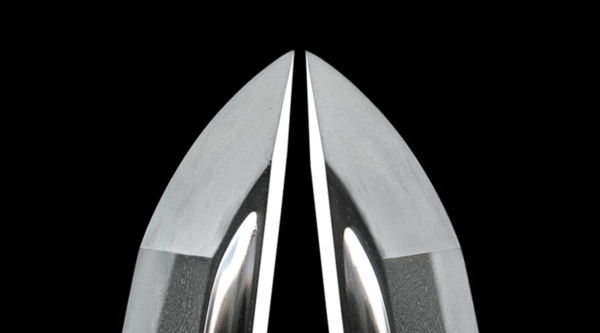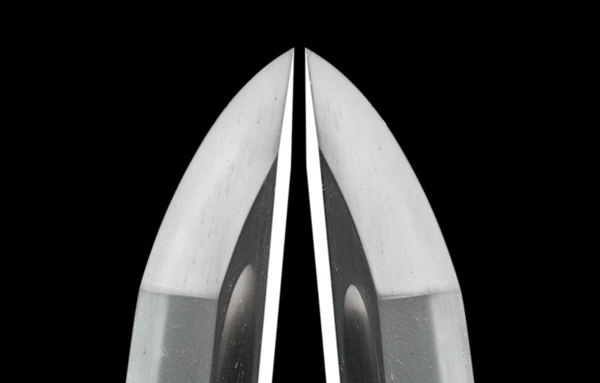-
Posts
279 -
Joined
-
Last visited
-
Days Won
2
Content Type
Profiles
Forums
Events
Store
Downloads
Gallery
Everything posted by xiayang
-
John is right. Just for completeness, the signature reads: 地井武男 = Chii Takeo Chinese fakes often come with random Japanese names inscribed on the tang.
-
伊豫住藤原宗貞 = Iyo ju Fujiwara Munesada
-

Shin-Gunto Mei Translation - Help please
xiayang replied to Nihondave's topic in Translation Assistance
It's Sukefusa, I think: 濃州関前川助房作之 See the discussion here. -
Much clearer now. Looks like I mistook a right (右) for a left (左)... Small correction: 嶋田七郎右衛門尉源義助 = Shimada Shichirōuemon no Jō Minamoto Yoshisuke 享保三天玄楮 The same blade was discussed here on this board not so long ago.
-
The second one is not so easy to decipher on these images. My best guess for the mei is: 嶋田七郎左衛門尉源義助 = Shimada Shichirōzaemon no Jō Minamoto Yoshisuke The date appears to start with: 享保三 = Kyōhō 3 (1718 CE)
-
丹波守藤原照門 = Tanba no Kami Fujiwara Terukado
-
三原住正清 = Mihara ju Masakiyo
-
Hi Ben, I'd say the mei is 濃州清舟作 The Japanese reading of this would be Nōshū Kiyofune saku, but I suspect this is actually a Taiwanese-made blade. There's a knife and sword manufacturing company registered under that name in Taiwan (see here or Google-translated version here).
-

Help translating komonjo sword(assuming its gimei)
xiayang replied to jdawg221's topic in Translation Assistance
平成六年十二月日 = on a day in December Heisei 6 (= 1994 CE) 繁平作 = Shigehira saku The mei looks a bit sketchy indeed, compared with this or this one. -
毛利圀元作 = Mori Kunimoto saku The character for Kuni is a somewhat uncommon variant of 國/国.
-

Character identification on tang of this sword
xiayang replied to Robert67's topic in Translation Assistance
小林國道 = Kobayashi Kunimichi- 1 reply
-
- 1
-

-
Looks like 義忠 = Yoshitada 昭和二十年五月 = May of Showa 20 (1945 CE)
-
This is a Chinese 4-character idiom which goes back to the 18th century painter and calligrapher Zheng Banqiao (鄭板橋). The calligraphy is meant to be read from the right to the left. In left-to-right ordering it is: 難得糊塗 Literally translated, this means something like "rarely confused", but as is usually the case with these idioms, the proper meaning is a lot deeper. You can find a long essay on this idiom here, if you're interested.
-
関住則光 = Seki ju Norimitsu
-
Sesko's Index of Japanese Swordsmiths doesn't appear to have an has only a one-line entry for this Sadatsugu, but if you search Google for 備中國住青江貞次造之, there are a couple of relevant hits: https://www.kusanaginosya.com/SHOP/344.html https://www.nipponto.co.jp/swords6/KY332581.htm The kusanaginosya.com link has some more information: his real name was 佐藤 丈平 (Sato Johei[?]) and he passed away in Showa 39 (1964 CE) at the age of 62 years. He's also listed here as Sato Sadatsugu (Okayama).
-
左衛門三郎左 = Saemon Saburō Sa
-
駿州島田住 = Sunshu Shimada ju 参河守源貞助 = Mikawa no Kami Minamoto Sadasuke
-
清水忠次作 = Shimizu Tadatsugu saku
-
That must be it, indeed. Now that you mention it, in the second picture you can see that even the geometry of the kissaki is asymmetric. That makes it even worse, argh! Thanks to everyone who replied!
-
I'd like to share an observation that has been puzzling me, and perhaps some of you may be able to shed light on this: I've noticed that some blades appear to have asymmetrically carved hi. Now I may perhaps be a bit peculiar in this regard, but to be honest, this greatly upsets my sense of aesthetics. Just to avoid misunderstandings, I'm not talking about cases where the asymmetry is clearly intentional (e.g., bohi on one side, futasuji-hi on the other, like this one). I am referring to examples where the length of the bohi differs by just a few millimetres, like in the two images attached below [found on aoijapan.jp]. Both of these blades were attributed to well-regarded koto makers and designated juyo token, so they were evidently recognised as high-quality items. Given the precision and attention to detail that is normally associated with nihonto-related crafts, this sort of seemingly accidental asymmetry strikes me as odd. Is it just sloppy workmanship of whoever carved the hi, possibly indicative of ato-bori, or a poor polishing job? Might this even be intended for functional reasons (balance)? And would this be considered a flaw and affect the value of the blade? It certainly does to me... Or do people think this gives the blade a sort of rustic charm? Is there something obvious I'm missing here?
-
濃州住兼俊作 = Noshu ju Kanetoshi saku
- 1 reply
-
- 3
-

-
There's an article on a Mr Ishii Jun’ichi on the Japanese Wikipedia: https://ja.wikipedia.org/wiki/石井順一 He was a baseball player, coach and manufacturer of baseball equipment and spent some time in the US in the 1920s. Perhaps this is a container for a baseball bat?



